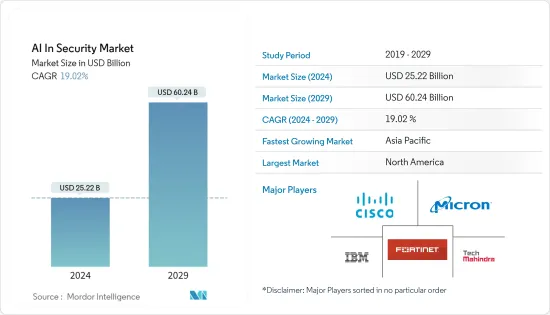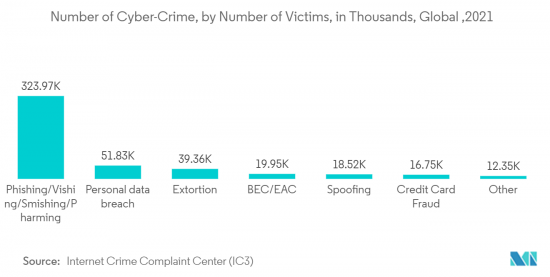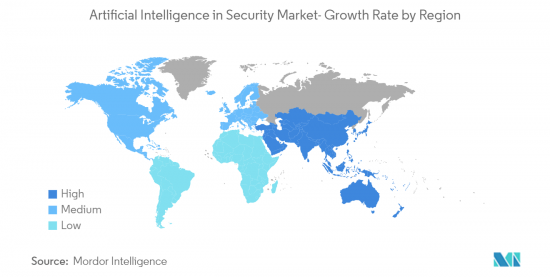 |
市場調查報告書
商品編碼
1430579
安防領域的人工智慧 -市場佔有率分析、產業趨勢與統計、成長預測(2024-2029)AI In Security - Market Share Analysis, Industry Trends & Statistics, Growth Forecasts (2024 - 2029) |
||||||
※ 本網頁內容可能與最新版本有所差異。詳細情況請與我們聯繫。
2024年安全領域人工智慧市場規模預計為252.2億美元,預計到2029年將達到602.4億美元,在預測期內(2024-2029年)年複合成長率為19.02%。

主要亮點
- 隨著互聯企業、設備和應用程式數量的增加,企業連接到大量獨立端點,增加了其漏洞。因此,安全領域的人工智慧為持續監控和適應現代數位化經濟面臨的多方面安全漏洞所需的主動威脅緩解能力提供了一個有吸引力的提案。
- 人工智慧及其應用程式可以透過提供降低風險的即時警報來保護任何系統。組織內可用的資料用於訓練這些系統。今年 2 月,國防部設立了一個新職位“首席資料和人工智慧官辦公室”,取代 2018 年成立的 JAIC(綜合人工智慧中心),作為該部門的執行官,負責加強和人工智慧整合數據、人工智慧和數位解決方案。已經推出。
- 透過引入使用人工智慧的機器學習,不僅可以檢測威脅和惡意軟體,還可以防止它們的發生。預計這將在預測期內為安防市場中的人工智慧創造巨大的市場機會。 2022年5月,美國參議院軍事委員會網路小組委員會就在電腦網路空間利用人工智慧和機器學習的重要性舉行了國會聽證會。谷歌和喬治城大學安全與新興技術中心的代表也參加了聽證會。
- 對更多熟練人工智慧專業人員的需求和缺乏意識預計將在預測期內抑制市場。根據 IBM Security 的報告,在完全實施人工智慧 (AI) 時,與沒有 AI 的組織相比,擁有 AI 的組織可節省高達 305 萬美元。今年資料外洩的平均成本為 435 萬美元,比去年的 424 萬美元成長了 2.6%。
雲端領域預計將以更快的速度成長
防毒/反惡意軟體提供成長潛力
- 惡意軟體變得越來越智慧,需要人工智慧和機器學習技術來對抗惡意軟體。防毒軟體和反惡意軟體都屬於更廣泛的網路安全範疇。從企業主管到成為網路釣魚詐騙和試圖存取敏感資訊的駭客攻擊目標的日常消費者,網路安全越來越令每個人頭痛。
- 現代網路攻擊者的策略、技術和程序變得更快、更多產,勒索軟體、網路釣魚和軟體供應鏈攻擊等高級威脅正在爆炸式成長。此外,為了應對這些挑戰,公司正在開發、維護並不斷更新其網路安全策略和解決方案。例如,2022年8月,安全技術領導者Prosegur Security和視覺AI領導者Everseen宣布計畫利用人性化的人工智慧解決方案重新構想零售和其他產業的實體安全,我們已經合作。這種夥伴關係加強了安全流程,並專注於創新。
- 根據消費者技術協會的數據,全球 44% 的組織已部署人工智慧應用程式來偵測和阻止安全入侵。網路安全中的人工智慧提高了系統的效率和準確性,以觀察對組織策略的任何潛在威脅。澳洲訊號局助理國防部長安德魯·哈斯蒂表示,澳洲政府將在未來10年花費68億美元來發展澳洲訊號局(ASD)的攻防網路和情報能力。我們計劃採取措施來加強這一點。
- 隨著公司逐漸轉向採用網際網路進行大部分業務,員工被迫長時間線上並創建大量資料,增加了網路攻擊和駭客攻擊的風險。Masu。因此,透過利用機器學習和人工智慧,可以在短時間內減少大量資料,幫助企業識別安全威脅並從中恢復。

亞太地區將經歷最高成長
- 亞太地區數位經濟快速發展。然而,它也增加了與威脅相關的機會。據思科稱,亞太地區的企業每分鐘就會收到 6 個威脅,所有網路攻擊中有 51% 造成 100 萬美元或以上的損失。
- 網際網路的普及和內部流程數位化的轉變正在幫助推動雲端基礎的服務的採用。在亞太地區數位轉型的同時,無效的網路法律和缺乏網路安全意識意味著亞太地區的企業成為駭客攻擊目標的可能性比其他地區高出80%。今年7月,韓國FSC(金融服務委員會)和FSS(金融監督院)公佈了金融服務人工智慧指南。這些指南將在人工智慧安全系統的責任、準確性、安全性、透明度、公平性和消費者權利方面指導產業。
- 此外,許多國家/地區已通過法規並制定了獨立計劃,以創建「單一事實資訊來源」並向銀行和零售商提供檢驗的數位客戶 ID。馬來西亞的「MyKad」、新加坡的「MyInfo」和泰國的「數位身分證」都旨在促進和加快身分驗證。這為人工智慧在安全市場創造了巨大的潛力。
- 所有上述因素預計將在預測期內支援人工智慧在區域安全市場的成長。例如,今年 2 月,IBM 宣布對其資源進行數百萬美元投資,幫助企業應對和管理全部區域組織日益成長的網路攻擊威脅。此次收購還包括一個新的安全營運中心 (SOC),該中心將為亞洲客戶提供 24x7 安全回應服務,作為 IBM 現有全球 SOC 廣泛網路的一部分。

人工智慧在安全領域的概述
由於近年來網路攻擊的增加,隨著許多新公司正在開發創新技術,安全市場中的人工智慧變得競爭激烈且分散。人工智慧(AI)是一個快速發展的技術領域,吸引了商業投資者、國防知識分子、政策制定者和國際競爭對手的注意。因此,這個市場的競爭正在加劇。參與者包括 IBM 和Cisco。
- 2023 年 11 月,Palo Alto Networks 宣佈在安全性方面增加新的人工智慧相關功能。該功能已添加到該公司的 Cortex 安全自動化智慧產品線中。這一添加遵循了發現和消除威脅和漏洞的自動化趨勢。
其他福利:
- Excel 格式的市場預測 (ME) 表
- 3 個月的分析師支持
目錄
第1章 簡介
- 研究假設和市場定義
- 調查範圍
第2章調查方法
第3章執行摘要
第4章市場動態
- 市場概況
- 市場促進因素
- 安全詐騙和技術滲透率增加
- 整個雲端運算生態系統中惡意軟體攻擊(勒索軟體)的增加
- 市場限制因素
- 缺乏熟練的人工智慧專家
- 產業價值鏈分析
- 產業吸引力-波特五力分析
- 新進入者的威脅
- 買家/消費者的議價能力
- 供應商的議價能力
- 替代品的威脅
- 競爭公司之間敵對關係的強度
第5章市場區隔
- 按安全類型
- 網路安全
- 應用程式安全
- 雲端安全
- 按服務
- 專業服務
- 管理服務
- 按發展
- 本地
- 雲
- 按最終用戶產業
- 政府/國防
- 零售
- BFSI
- 製造業
- 衛生保健
- 汽車與運輸
- 其他最終用戶產業
- 按地區
- 北美洲
- 美國
- 加拿大
- 歐洲
- 英國
- 德國
- 法國
- 義大利
- 西班牙
- 歐洲其他地區
- 亞太地區
- 中國
- 日本
- 印度
- 韓國
- 其他亞太地區
- 世界其他地區
- 拉丁美洲
- 中東/非洲
- 北美洲
第6章 競爭形勢
- 公司簡介
- IBM Corporation
- Facebook Inc
- F-Secure Corporation
- Tech Mahindra Limited
- Cisco Systems Inc
- Nvidia Corporation
- Samsung Electronics Co., Ltd
- Xilinx, Inc
- ThreatMetrix Inc(RELX Group)
- Broadcom Inc.(Symantec Corporation)
- Fortinet, Inc
- Juniper Network, Inc
- Micron Technology, Inc
第7章 市場機會及未來趨勢
第8章投資分析
The AI In Security Market size is estimated at USD 25.22 billion in 2024, and is expected to reach USD 60.24 billion by 2029, growing at a CAGR of 19.02% during the forecast period (2024-2029).

Key Highlights
- With the rise in connected enterprises, devices, and applications, businesses are becoming more vulnerable as they are connected to a mass of independent endpoints. Therefore, AI in security provides an enticing proposition with its proactive threat mitigation capabilities, which are needed for constant supervision and adaptation to the multifaceted security vulnerabilities faced by the modern digitalized economy.
- AI and its applications allow users to protect any system by providing alerts to them in real-time to mitigate risk. The data available within the organizations are being used to train these systems. In February of the current year, DOD stood up the new position of the Office of the Chief Digital and AI Officer to serve as the department's senior official responsible for strengthening and integrating data, AI, and digital solutions and replacing the JAIC (Joint Artificial Intelligence Center) established in 2018.
- Implementing machine learning with AI enables threats and malware to be proactively prevented rather than only detected. This is expected to help create a huge market opportunity for artificial intelligence in the security market during the forecast period. In May 2022, the US Senate Armed Forces Committee's Subcommittee on Cyber held a congressional hearing on the importance of leveraging artificial intelligence and machine learning within cyberspace. This hearing included representatives from Google and the Center for Security and Emerging Technology at Georgetown University.
- The need for more skilled AI professionals and lack of awareness are expected to restrain the market during the forecast period. According to a report by IBM Security, artificial intelligence (AI), when fully deployed, provided the most significant cost mitigation, up to USD 3.05 million less at organizations with AI than organizations without AI. Data breach average cost increased by 2.6% from USD 4.24 million in the last year to USD 4.35 million in the current year.
Cloud segment is expected to grow at a higher pace
Antivirus/Anti-malware Offers Potential Growth
- Artificial intelligence and machine learning techniques are needed to counter-attack malicious software, with the malware getting more intelligent daily. Both antivirus and anti-malware fall under the broader term of cybersecurity. Cybersecurity is increasingly becoming a headache for everyone, from corporate executives to regular consumers, who are targeted by phishing scams and hackers attempting to access sensitive information.
- Modern cyber attackers' tactics, techniques, and procedures have become both rapid and abundant, while advanced threats such as ransomware, phishing, and software supply chain attacks are explosive. Further, to stand up to these challenges, businesses are developing, maintaining, and constantly updating their cybersecurity strategies and solutions. For instance, in August 2022, Prosegur Security, a leader in security technology, and Everseen, the leader in visual AI, partnered to reimagine physical security in retail and other industries using human-centric artificial intelligence solutions. The partnership will enhance security processes through a shared focus on innovation.
- According to the Consumer Technology Association, 44% of organizations across the globe are implementing AI applications to detect and deter security intrusions. Artificial intelligence in cybersecurity increases the efficiency and precision of the system to observe any potential threat in the organization's strategy. According to the Australian Signals Directorate, Andrew Hastie, assistant minister for defense, the Australian government is expected to spend USD 6.8 billion over the coming decade on measures to enhance the offensive and defensive cyber and intelligence capabilities of the Australian Signals Directorate (ASD).
- The gradual shift of enterprises toward adopting the internet to perform most tasks is compelling employees to remain online for a longer time and create a lot of data, thus increasing the risks for cyber-attacks and hacking. Thus with machine learning and AI, that peak of data could be carved down in a fraction of the time, helping the enterprise to identify and recover from the security threat.

Asia-Pacific to Witness the Highest Growth
- In Asia-pacific, great strides are being made in the digital economy. But it is also causing more threat-related opportunities. According to Cisco, companies receive six threats every minute in APAC, and 51% of all cyber-attacks result in a loss of more than USD 1 million.
- The growing penetration of the internet and the shift toward digitization of internal processes have been instrumental in driving the adoption of cloud-based services. Alongside the digital transformation in the region, owing to ineffective cyber laws and lack of cybersecurity awareness, companies in Asia-Pacific are 80% more likely to be targeted by hackers than in other regions. In July this year, Korea FSC (Financial Services Committee) and FSS (Financial Supervisory Service) announced AI Guidelines in Financial Services, which guide the industry on the responsibility, accuracy, safety, transparency, fairness, and consumer rights relating to AI security systems.
- Moreover, many countries have passed regulations and created independent programs to create a "single source of truth" and provide banks and retailers with verified digital customer identities. Malaysia's MyKad, Singapore's MyInfo, and Thailand's Digital ID are all designed to facilitate and speed up identity verification. This creates a huge scope for AI in the security market.
- All the above factors are expected to support the growth of artificial intelligence in the security market in this region during the forecast period. For instance, in February this year, IBM announced a multi-million dollar investment in its resources to help businesses prepare for and manage the growing threat of cyberattacks to organizations across the APAC region. The acquisition also includes a new Security Operation Center (SOC), part of IBM's vast network of existing global SOCs providing 24X7 security response services to clients around the region.

Artificial Intelligence (AI) in Security Industry Overview
Artificial intelligence in the security market is highly competitive and fragmented as many new companies are developing innovative technologies due to the rise in cyber attacks over the years. Artificial intelligence (AI) is a rapidly growing field of technology that is capturing the attention of commercial investors, defense intellectuals, policymakers, and international competitors. This is making this market more competitive. A few players are IBM Corporation, Cisco Systems Inc., etc.
- In November 2023, Palo Alto Networks Inc. announced the addition of fresh features that are artificial intelligence-related to security. The features are added to its Cortex security automation and intelligence product line. The addition is made following the automation trend in finding and eliminating threats and exploits.
Additional Benefits:
- The market estimate (ME) sheet in Excel format
- 3 months of analyst support
TABLE OF CONTENTS
1 INTRODUCTION
- 1.1 Study Assumptions and Market Definition
- 1.2 Scope of the Study
2 RESEARCH METHODOLOGY
3 EXECUTIVE SUMMARY
4 MARKET DYNAMICS
- 4.1 Market Overview
- 4.2 Market Drivers
- 4.2.1 Increasing Number of Security Frauds and Technology Penetration
- 4.2.2 Increasing Number of Malware Attacks (Ransomware) across Cloud Computing Ecosystem
- 4.3 Market Restraints
- 4.3.1 Lack of Skilled AI Professionals
- 4.4 Industry Value Chain Analysis
- 4.5 Industry Attractiveness - Porter's Five Force Analysis
- 4.5.1 Threat of New Entrants
- 4.5.2 Bargaining Power of Buyers/Consumers
- 4.5.3 Bargaining Power of Suppliers
- 4.5.4 Threat of Substitute Products
- 4.5.5 Intensity of Competitive Rivalry
5 MARKET SEGMENTATION
- 5.1 By Security Type
- 5.1.1 Network Security
- 5.1.2 Application Security
- 5.1.3 Cloud Security
- 5.2 By Service
- 5.2.1 Professional Services
- 5.2.2 Managed Services
- 5.3 By Deployment
- 5.3.1 On-premise
- 5.3.2 Cloud
- 5.4 By End-user Industry
- 5.4.1 Government & Defense
- 5.4.2 Retail
- 5.4.3 BFSI
- 5.4.4 Manufacturing
- 5.4.5 Healthcare
- 5.4.6 Automotive & Transportation
- 5.4.7 Other End-user Industries
- 5.5 By Geography
- 5.5.1 North America
- 5.5.1.1 United States
- 5.5.1.2 Canada
- 5.5.2 Europe
- 5.5.2.1 United Kingdom
- 5.5.2.2 Germany
- 5.5.2.3 France
- 5.5.2.4 Italy
- 5.5.2.5 Spain
- 5.5.2.6 Rest of Europe
- 5.5.3 Asia-Pacific
- 5.5.3.1 China
- 5.5.3.2 Japan
- 5.5.3.3 India
- 5.5.3.4 South Korea
- 5.5.3.5 Rest of Asia-Pacific
- 5.5.4 Rest of the World
- 5.5.4.1 Latin America
- 5.5.4.2 Middle-East & Africa
- 5.5.1 North America
6 COMPETITIVE LANDSCAPE
- 6.1 Company Profiles
- 6.1.1 IBM Corporation
- 6.1.2 Facebook Inc
- 6.1.3 F-Secure Corporation
- 6.1.4 Tech Mahindra Limited
- 6.1.5 Cisco Systems Inc
- 6.1.6 Nvidia Corporation
- 6.1.7 Samsung Electronics Co., Ltd
- 6.1.8 Xilinx, Inc
- 6.1.9 ThreatMetrix Inc (RELX Group)
- 6.1.10 Broadcom Inc. (Symantec Corporation)
- 6.1.11 Fortinet, Inc
- 6.1.12 Juniper Network, Inc
- 6.1.13 Micron Technology, Inc













